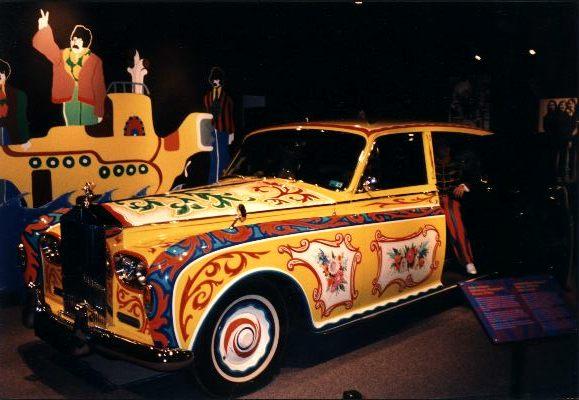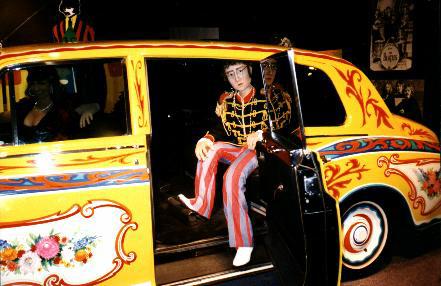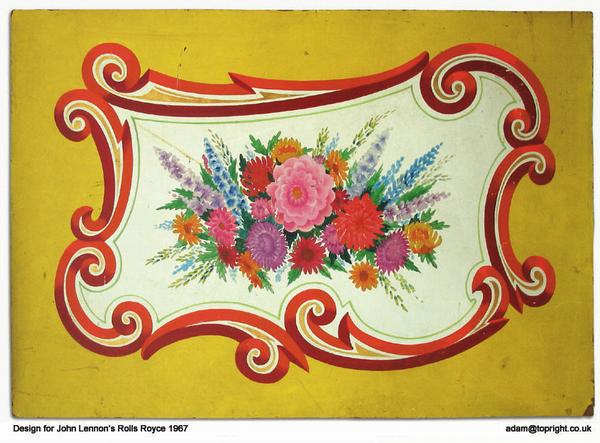
|
Beautiful car, isnít it? This car was manufactured in 1965 by
the Rolls-Royce Motor Cars Limited, Crewe, Cheshire. The car was fitted
with a limousine body by Mulltner Park Ward and finished in Valentines
Black.
When completed, the Phantom V was then delivered to John
Lennon on June 3, 1965 with the license plate number being FJB111C. A
guarantee was issued to John Lennon on 10 June 1965. The car measured 19
feet long and weighed three tons.
On December 21, 1965, John ordered a Sterno Radio
Telephone and the number WEYBRIDGE 46676 assigned to it.
In 1966, the car had the rear seat modified to convert to
a double bed. A custom interior/exterior sound system was installed along
with a "loud hailer." Other features that John Lennon had installed at
this time were: Sony television; telephone and a portable refrigerator. On
January 7, the car went in for a mileage check and the odometer had
recorded 6,673 miles and on March 28, that same year, the car clocked in
at 11,181 miles. Later, on February 4, in 1967, the odometer would record
29,283 miles clocked on the Rolls-Royce. Interestingly enough, John had
his chauffeur and car sent over to Spain in 1966, while he was filming
"How I Won the War". It was reported that his Rolls-Royce Phantom V was
painted with a matt black overall, which included the radiator and chrome
trim.
But John eventually became restless with the "matt black
overall" on the car and so in April of 1967, he took it upon himself to
visit J.P. Fallon Limited, a coachworks company located in Chertsey,
Surrey. He had in mind the possibility of having his car painted
"psychedelic". This was based on an idea by Johnís newly painted psychedelic car drew some public
outrage when a old woman, in Londonís downtown, attacked the car using her
umbrella and yelling: "You swine, you swine! How dare you do this to a
Rolls-Royce." Obviously, the Rolls-Royce is passionately regarded in
England as one of the many symbols of British dignity!
The Beatles used the Rolls exclusively in their heyday
from 1966 to 1969.
In 1970, John Lennon and Yoko Ono had the Phantom V
shipped to the United States. The car was loaned out to several rock stars
such as the Rolling Stones, the Moody Blues, and Bob Dylan. When the car
was available, the Lennonís seldom used it and so consideration was given
to sell it to an American buyer -- but a deal never materialized. As a
result, the car was put into storage in New York City.
Then in December, 1977, John and Yoko had serious
problems with the United States Internal Revenue. The couple arranged to
have a deal worked out where they would donate the car to the
Cooper-Hewitt Museum in New York City, a part of the Smithsonian
Institute, for a $225,000 tax credit.
From October 3, 1978 to January 7, 1979, the car was put
on public display at the Cooper-Hewitt Museum and then returned to storage
at Silver Hill, Maryland. There, the car would remain in storage and kept
from public viewing for a while. The reason for this was because the
museum could not afford the insurance coverage for public viewing on a
full-time basis.
On June 29, 1985, the Cooper-Hewitt Museum decided to
auction the car off through Sothebyís. Before the auction began, The
Rolls-Royce Phantom V was estimated by Sotheby's to fetch between $200,000
to $300,000 (U.S.). When the car was sold, it pulled in a surprising
$2,299,000 (U.S.) and was purchased by Mr. Jim Pattisonís Ripley
International Inc., of South Carolina for exhibition at Ripleyís "Believe
It Or Not" museum. The purchase of the Phantom V through Sothebyís
resulted it being listed as the most expensive car in the world and
installed with the South Carolina license plates LENNON.
The Phantom V was then loaned to Expo Ď86 in Vancouver
(Chairman: Mr. Jim Pattison) for exhibition. The American title was
transferred from Ripley International Inc. to Jim Pattison Industries
Ltd., in Canada (Mr. Jim Pattison is a well-known British Columbia
business man.)
In 1987, Mr. Pattison presented the car as a gift to Her
Majesty in Right of the Province of British Columbia and displayed in the
Transportation Museum of British Columbia at Cloverdale (near Vancouver).
Then, in 1993, the car was transferred from the
Transportation Museum and sent to the Royal British Columbia Museum in
Victoria, British Columbia. Here the car would be kept for secure storage,
displayed only for fund-raising and occasional use. The car was serviced
and maintained by Bristol Motors of Victoria.
In order to protect the paint work on John Lennon's
famous Rolls-Royce Phantom V, the Royal Royal British Columbia
Museum requested that the Canadian Conservation Institute (CCI) do a paint
analysis on the car. Here are the test results as reported from the CCI:
"Samples were mounted as
cross sections to determine the structure of the paint layers. Paint
chips were also analysed using Fourier transform infrared
spectroscopy, X-ray diffraction, X-ray microanalysis, and polarized
light microscopy. The analysis revealed that both cellulose nitrate
and an oil-modified alkyd resin media had been used and that the
surface of the paint had been coated with an oil-modified alkyd
resin varnish. A colourful array of pigments was identified,
including chrome yellow, titanium white, ultramarine blue, and
toluidine red.
"Based on the materials
identified, cleaning and waxing the car was recommended; the
analysis showed there was nothing in the paint that would be harmed
by water or by the application of a protective wax coating. To
minimize damage to the varnish and painted surface, it was also
recommended that the car not be exposed to direct sunlight for long
periods as this could cause deterioration of both the cellulose
nitrate and the alkyd resin." However, over the years the car has had some paint
cracking on the original top coat. Restoration work was applied.
From 9 March 1996 to 15
September 1996, John Lennonís Rolls-Royce Phantom V was displayed at
the National Museum of Science and Technology in Ottawa, with as
passenger a sculpture of John by Joanne
Sullivan.
"During the making of
Sergeant Pepper John decided to have the Rolls-Royce painted.
Colour and design were of the utmost priority and he employed a firm
of barge and caravan designers to do it for him. The idea came to
him when he bought an old gypsy caravan for the garden." --
Cynthia Lennon, from her book, "A Twist of Lennon", page
142. - Researched by John Whelan, Additional material, April 28,
2001, from promotional flyers issued by the Ottawa Museum of Science and
Technology in 1996 and with one final update entered to this page on March
24, 2003, culled from the Canadian Conservation Institute at: http://www.cci-icc.gc.ca/whats-new/news21/lennon_e.shtml
On June 19 2008, we received the following message:
To: northern_reflection@msn.com Dear Mr Whelan.
I have just read with interest your feature
on the psychedelic Rolls Royce of John Lennon and thought you may be
interested in some more recent additional information I have relating to
the concept, design and production of its paint work. Inevitably the
reality differs somewhat from the myth that surrounds the identity of the
artist who created the design. I researched the history to establish
the provenance of the original design proof that I was given following the
death of my father-in-law and to establish the actual events. The
internet, The UK Public Records Office and The Royal British Columbia
Museum were all very helpful in leading me to the actual events.
The inspiration for the design came from Marijke
Koger, one of the design collective 'The Fool' who were responsible for
numerous seminal pieces of the period and were very influential in the
psychedelic art movement. Marjke emailed me about the design; ďI was
staying at John's house in 68 [she miss-states the date] to paint his
piano and he had a painted gypsy wagon in is garden. I suggested to him
that he paint the Rolls like the gypsy wagon, which he thought was a great
idea so he contacted the genuine gypsies who made the wagon and they
actually did the painting on the Rolls.Ē
Marijke Koger was apparently unaware of who
actually painted the Rolls Royce as it was local artist Steve Weaver
who created the design for John to realised his vision. He clearly
liked Weaver's design, as this was then painted on John's Rolls Royce by
Weaver at the JP Falon, Coachbuilders works. Weaver was paid £290 for his
artwork.
Steve Weaver is now deceased so he can't
tell his own story. However his daughter remembers the time and she
confirmed that the design painting I have is the original that was
prepared for Lennon by her father. Weaver's daughter was interested in my
father-in-law's connection to her father, and revealed that he ďhad a
younger man help him with the carĒ. It is quite possible that this was my
father-in-law, also an accomplished artist who was working in the area at
that time.
I met with Weaver's daughter who was
delighted to see the design again and provided me with documents to
support the story and authenticate the design. They consist of: a signed
authentication by the artistís daughter; a photographic copy of Weaverís
£290 invoice for work and materials dated May 24th 1967; a photographic
copy of an application to the Patent Office to register the design, dated
19th June 1967 signed by the artist; an email from Marijke Koger
commenting on the origins of the work.
I have attached a photograph of the artwork
and a couple of the other pieces for your interest. It measures 24"
x 36" (600mm x 900mm) and is in 'as-found' condition as you can see.
Please feel free to contact me if you'd like to use any of this on your
website or if you'd like any more background info.
On January 12, 2011, we received
the following message: John Lennon's custom painted Rolls Royce (RBCM
992.64.1) is now on display in the lobby of the Royal British
Columbia Museum until June 2011. In the last year new material has come to light. Using
www.britishpathe.com I am
now convinced it did take the Beatles to Buckingham Palace to
receive their MBEs, when it was still its original colour,
Valentine's Black. There is also now good footage of the
Caravan painted (possibly by Steve Weaver, but certainly at J.P.
Fallon's coach building firm, where the car was painted later) that
was the inspiration for painting the Rolls. The caravan was
delivered the month following Sergeant Pepper's and the logo for
that album is clearly visible on the back of the Caravan. Also
located are films of the car after being painted, including interior
shots of the television. Original car
colour was Valentine's black.
http://www.britishpathe.com/record.php?id=41111. In stills mode,
in 1 second slices at 00:46 you can clearly read the license plate FJBIIIC
which is this car. Dr. Lorne Hammond, Curator of History Related link of interest: Rolls-Royce Enthusiasts Club
1st update was done April 28, 2001; |




